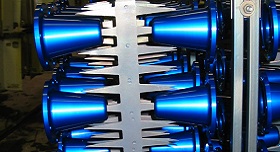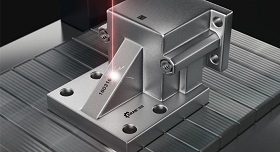Surface Finish
Finishing machines treat the surface of your custom part. Finishing can be used for protection, decoration, and other uses. For example you may want to nickel plate a part to protect it from oxidizing or mechanically brush the surface of the part to create a textured look. Ego’s engineering team will also guide you to make sure the finish you specify is compatible with your material.
Ego Surface Finish Services
 |
 |
 |
||
| Powder Coating | Anodizing | Buff Polishing | ||
 |
 |
 |
||
| Surface Plating | Laser Marking | Metal Surface Finishing Tips |
Powder Coating
Powder coating looks similar to paint but is more durable.
Properties
Powder coating is a process that “bakes” powdered plastic onto a metal surface. The coating is relatively hard and abrasion resistant. Powder coating adds typically 0.0025″ to 0.005″ to each coated side and edge. Textured powder is less susceptible to imperfections than matte or glossy. This metal finish is available in many colors.
Design Considerations
The are several factors to consider in designing parts with powder coating as a finish. Consider compensating for surface finish thickness – typically .001 to .003″ on each surface. Edges will be slightly rounded due to the thickness of the coating. Textured powder coat will hide scratches and abrasions better than glossy powder coat. Coating may not reach certain deep pockets and inside corners due to the electrostatic process. Mechanical finishing of surfaces prior to powder coating is not usually needed as the coating covers and smoothes the surface. Plain and tapped holes may acquire a small amount of powder which can sometimes interfere with threads. Redrilling or retapping can optionally be requested.
Powder Coating Colors
Ego offers powder coat finishing in numerous colors. The colors below viewed on your monitor or printed will vary from the true color of the actual powder coating due to computer system variations. Click to see more colors here.
Anodizing is mainly used for aluminum alloys.
Properties
Anodizing is a finish that protects metal by increasing the surface oxide layer. The process is often used to improve durability and enhance corrosion resistance. The metal finishing process can be used to provide various colors and improve wear resistance. It provide better adhesion for painting and reduces galling of threaded components.
Colors
Standard colors offered include: black, blue, red, gold and non-dyed.
The process creates a bright reflective shiny finish.
Properties
The finishing process creates a smooth near-mirror uniform surface. Polishing is done on the edge of a cloth buff wheel, typically about 6″ diameter and hence the process can only reach certain surfaces. Edges often become slightly rounded. Buff polishing may not be effective on parts with sharp, intricate, recessed or fragile features. Many materials can be buff polished including Aluminum, Stainless Steel, Copper, Steel, Acrylic, Brass, Titanium, Sterling Silver and Bronze. Hard materials such as stainless steel are more time consuming and costly to polish.
Electroplating is a metal finishing process used to finish your part surface by submersing the part in a tank of chemicals and applying an electric current. Electroplating coats or alters the part surface with a thin layer. Larger parts are usually plated on racks where the parts are hung before submersing. Barrel plating is often used for small parts where the parts sit at the bottom of a tank.
Properties
Electroplating does not substantially hide or smooth surface imperfections. For example if you mill a part with 63 surface finish and then silver plate, it will not have a polished look.
Examples
The process is often applied to decorative parts, sculptures, knobs, electrical connectors, handles, etc.
Laser Marking
Applications
Laser marking works great for adding text, logos, compliance symbols (e.g. UL etc), artistic designs and more to
a. Electronic consoles (labeling of buttons, switches, and connectors)
b. Tools
c. Automobile parts
d. Jewelry
e. Keychains
f. Phone cases
g. Signs
Advantages
Laser marking offers a low-cost way to add text and graphics to parts without expensive tooling. Text and graphics can be added to any flat surface in small or large fonts.
Compared to laser engraving, use of a low power laser helps keep cost down. Another advantage of laser marking over laser engraving and laser etching includes the fact that laser marking does not remove material.
Materials
Ego Manufacturing Group can laser mark:
a. Bare steel and stainless steel
b. Anodized aluminum
c. Any metal with powder coat
d. And many more materials
Design Considerations
When laser marking powder coated parts, we recommend using filled fonts. For other applications, both filled and outline fonts work well. Recommended minimum height of font is .08″ for anodized parts and .14″ for powder coated parts. The max size of a part we can laser mark is 22″ x 14″ x 2″.
